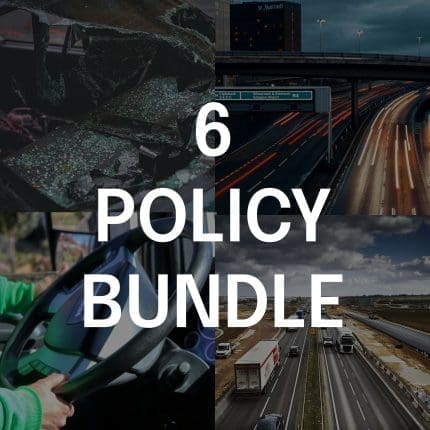- Shop All Documents + Bundles
- FORS V7.1 Document Bundle | Bronze (15 Policies)
- Transport Manager Compliance Pack (10 Policies)
- Transport Manager Compliance Pack (6 Policies)
- Health & Safety Policy Template
- Fuel, Emissions And Air Policy Template
- Operational Security Policy Template
- Serviceability And Roadworthiness Policy Template
- Road Traffic Collision Policy Template
- Counter Terrorism Policy Template
- Load Safety Policy Template
- Vehicle Routing And Scheduling Policy Template
- Driving Standards Policy Template
- Driving Hours Policy Template
- In Cab Technology Policy Template
- Passenger Safety Policy Template
- Complaints And Grievances Policy Template
- Drug And Alcohol Management Policy Template
- Hazard And Risk Identification Policy Template
- VOR (Vehicle Off Road) Policy Template
- Tyre + Wheel Policy Template
- Health & Eyesight Policy Template
- Transport Infringement Policy Template
- Walk Around Check (Defect Check) Tool Box Talk Template
- Transport Manager CV Template
- Social Media Policy Template
- Transport Manager Contract Template
- External Transport Manager Contract Template
- Driver Handbook
Transport UK > Transport Manager Shop > Tyre + Wheel Policy Template

Social Media Policy Template
£11.00 ex.VAT

VOR (Vehicle Off Road) Policy Template
£11.00 ex.VAT
Tyre + Wheel Policy Template
£11.00 ex.VAT
It is important to maintain actively maintain a robust Wheel & Tyre Policy.
⧉ PREVIEW: View our Test Document here to sample the format.
| Brand |
Transport UK |
|---|---|
| Document Format |
PDF [Digital Download] |
| Legislation |
UK Law |
| Transport Manager |
Transport Manager CPC ,Tyre + Wheel |
| Document Author |
Transport UK Industry Professionals |
| Technology |
Strictly No Artificial Intelligence (AI) Copywriting |
| How To Edit |
Microsoft Word |
| Product Type |
Digital Product [Downloadable] |
13
People watching this product now!
SKU:
TUK-TW-01
Category: Tyre + Wheel Policy
Tags: Transport Manager Compliance, Transport Manager CPC, Transport Manager Documents, Transport Manager Handbook, Transport Manager Resources
Description
Updated V7.1 – 03.12.24
Why do i need this document?
This policy is intended to be a guide to absolute minimum standards required to actively maintain a robust wheel and tyre policy. This covers the essential elements of the DVSA’s guidance to maintaining road worthiness. Wheel security and tyre standards is a permanent issue and requires a robust policy to ensure compliance. It is the responsibility of the management that this policy is distributed accordingly.
A tyre and wheel policy is a crucial document that outlines guidelines and procedures for the proper maintenance, usage, and replacement of tyres and wheels within an organisation’s vehicle fleet. This policy is essential to ensure the safety, efficiency, and cost-effectiveness of the fleet. Here are the reasons why having a tyre and wheel policy is important:
- Safety: The primary focus of a tyre and wheel policy is to prioritise safety for drivers, passengers, and other road users. It establishes guidelines for regular tyre inspections, proper tyre inflation, and tread depth checks to minimise the risk of accidents caused by tyre-related issues.
- Tyre Selection and Maintenance: The policy should include guidelines for selecting appropriate tyres for different vehicles and applications. It should also outline procedures for regular maintenance, such as rotations, alignments, and balancing, to extend the lifespan of tyres and ensure optimal performance.
- Replacement Criteria: The policy should define the criteria for tyre replacement, such as tread wear limits, sidewall damage, and age considerations. Following these criteria ensures that tyres are replaced at the right time, preventing potential blowouts and other hazardous situations.
- Quality Standards: The policy may specify quality standards for purchasing new tyres and wheels. This ensures that the organisation invests in reliable and durable products, reducing the risk of premature failures and costly replacements.
- Proper Wheel Maintenance: In addition to tyres, the policy should cover proper wheel maintenance, including inspection for cracks, damage, and correct torque specifications for wheel nuts. Properly maintained wheels contribute to overall road safety and vehicle performance.
- Winter Tyres and Chains: If applicable, the policy should address the use of winter tyres or snow chains in regions with severe winter weather conditions. This ensures drivers are equipped with appropriate equipment for safe driving in adverse weather.
- Tyre Storage and Handling: The policy may include guidelines for the proper storage and handling of spare tyres, especially if the organisation maintains a storage facility for excess tyres. This helps prevent damage and degradation during storage.
- Cost Management: A comprehensive tyre and wheel policy should aim to optimize costs without compromising safety and performance. This may involve strategies like retreading tyres, monitoring tyre wear patterns, and implementing fuel-efficient tyre choices.
- Driver Awareness and Training: The policy should emphasise the importance of driver awareness in identifying tyre issues and the appropriate steps to take if a problem is detected. Driver training on tyre safety and maintenance can significantly contribute to overall fleet safety.
- Supplier Relationships: The policy may include guidelines for selecting reputable tyre and wheel suppliers. Maintaining strong relationships with suppliers can lead to favourable pricing, timely deliveries, and access to quality products.
- Monitoring and Reporting: A tyre and wheel policy should outline procedures for monitoring tyre performance and reporting issues promptly. Regular tyre inspections and incident reporting enable proactive maintenance and corrective actions.
- Environmental Considerations: The policy may address environmental aspects, such as recycling old tyres and implementing eco-friendly practices related to tyre disposal and waste management.
In conclusion, a well-structured tyre and wheel policy is crucial for organisations with a vehicle fleet as it priorities safety, efficiency, and cost-effectiveness. By establishing clear guidelines and expectations for tyre and wheel maintenance, the policy contributes to the overall success of the fleet’s operations, ensures compliance with safety standards, and minimises the risk of accidents caused by tyre-related issues.
Reviews (0)
Only logged in customers who have purchased this product may leave a review.
How does it work?
We will deliver this digital document (PDF) instantly to you by email when you purchase it.
- Purchase
- Download
- Add your company logo/details
- Adjust/tailor to your requirements
- Be compliant
⧉ Want to try before you buy? View our Test Document here to sample the format in which our documents are made available to you.
Templates you can trust
Our templates are written by transport professionals with a combined 100 years experience in the industry, managing complex and large fleets.
Strictly NO artificial intelligence (AI) copywriting is used in our policies and documents.
You may also like…
Transport Manager Compliance Pack (6 Policies)
Driving Hours Policy, Driving Standards Policy, In Cab Technology Policy, Road Traffic Collision Policy, Tyre + Wheel Policy, VOR (Vehicle Off Road) Policy, Compliance Document Bundles
Rated 5.00 out of 5
Related products
FORS V7.1 Document Bundle | Bronze (15 Policies)
Complaints And Grievances Policy, Counter Terrorism Policy, Driving Hours Policy, Driving Standards Policy, Fuel, Emissions And Air Policy, In Cab Technology Policy, Load Safety Policy, Operational Security Policy, Passenger Safety Policy, Road Traffic Collision Policy, Serviceability And Roadworthiness Policy, Tyre + Wheel Policy, Vehicle Routing And Scheduling Policy, Compliance Document Bundles
Rated 5.00 out of 5














Reviews
There are no reviews yet.